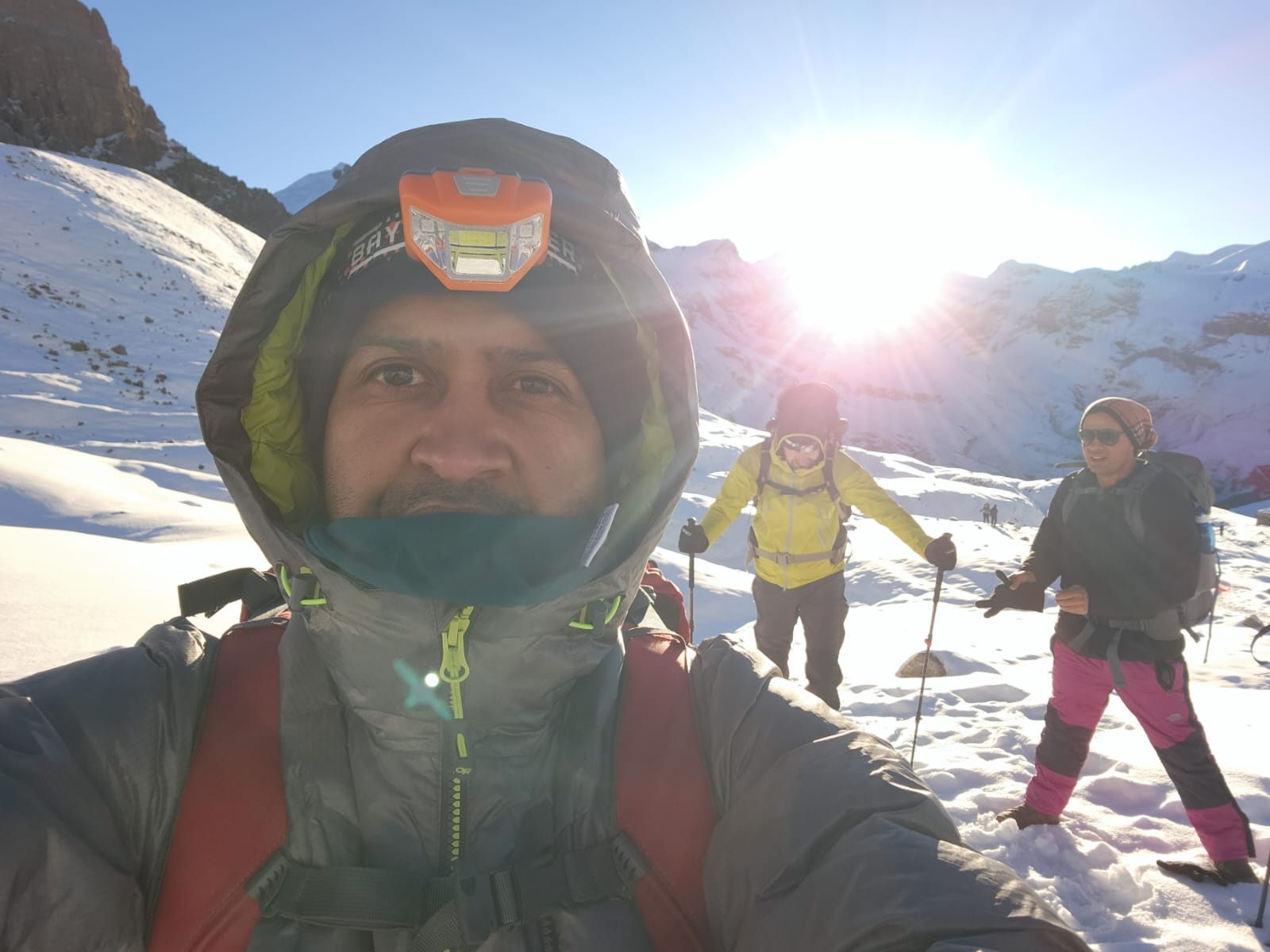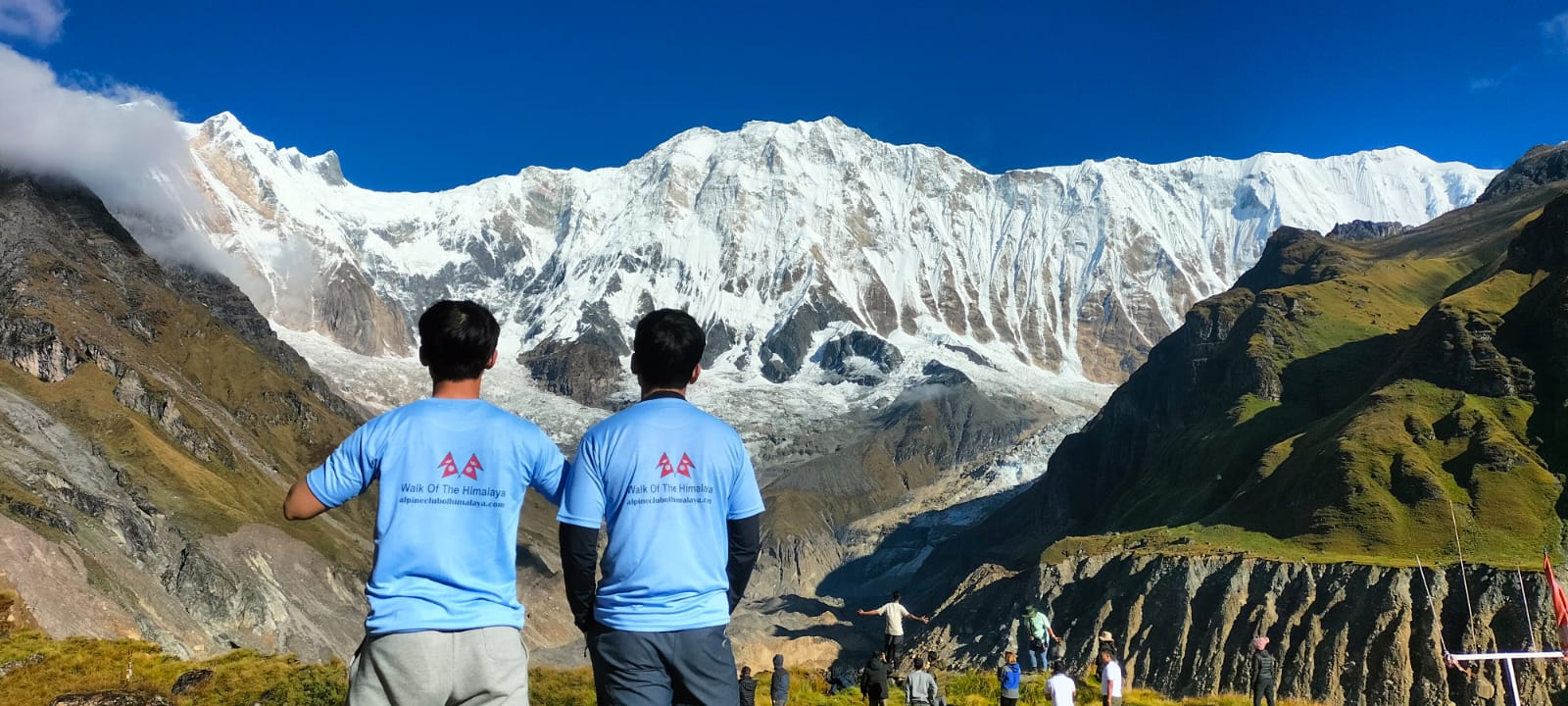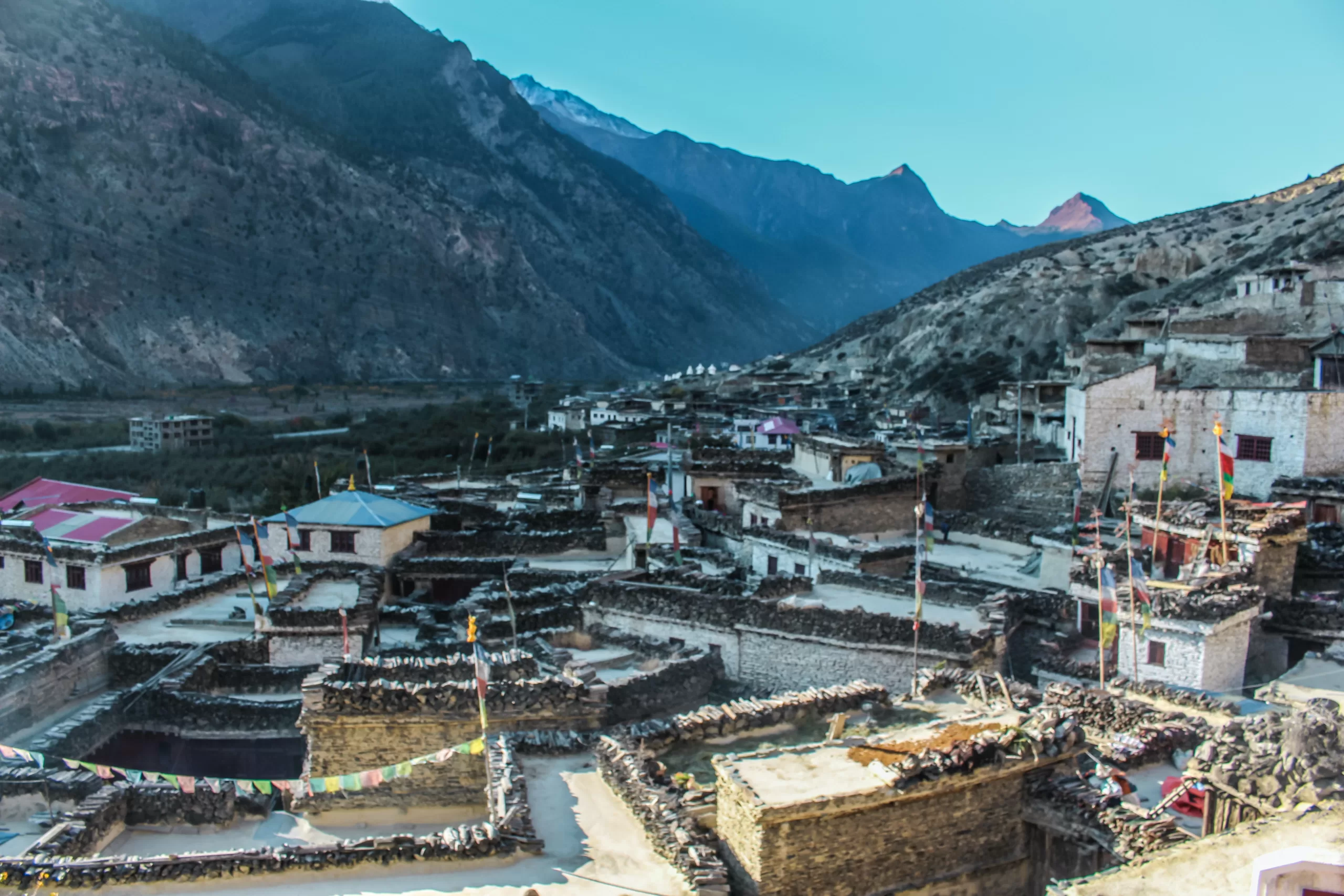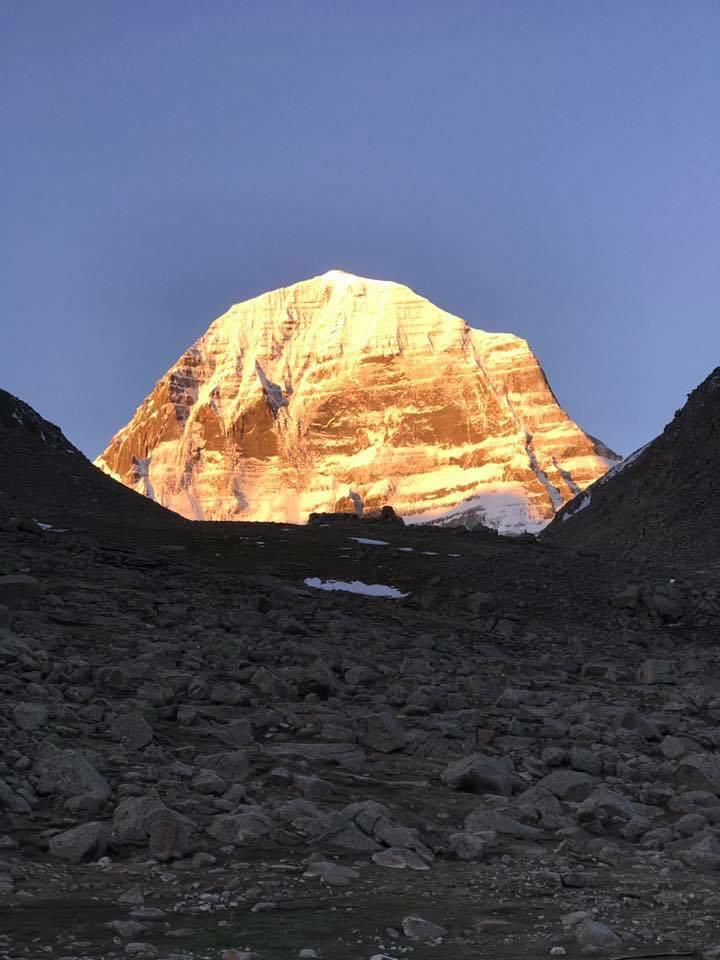Short Annapurna Circuit Trek: Discover the stunning Annapurna region with the Short Annapurna Circuit Trek by Alpine Club of Himalaya. This six-day adventure serves as an ideal introduction to one of the world’s most famous trekking routes, celebrated for its breathtaking landscapes, diverse ecosystems, and rich cultural heritage.
On this trek, you will navigate through lush valleys, terraced fields, and ancient forests, all while soaking in awe-inspiring views of the Annapurna massif. Designed for trekkers of all skill levels, this journey offers accessibility without compromising on excitement.
Each day presents unique experiences, from the warm hospitality of local tea houses to the serene beauty of alpine meadows. As you traverse picturesque villages, you’ll meet friendly locals, learn about their traditional lifestyles, and savor delicious Nepali cuisine.
A highlight of the trek is the crossing of Thorong La Pass, one of the highest trekking passes in the world. Here, you’ll be rewarded with panoramic views that will leave you breathless. Every step of this trek promises unforgettable memories that will last a lifetime.
Join Alpine Club of Himalaya on the Short Annapurna Circuit Trek and immerse yourself in the captivating beauty of the Annapurna region. Whether you’re an experienced trekker or a newcomer, this journey offers breathtaking scenery, cultural encounters, and an exhilarating adventure in the heart of the Himalayas.
Trek Highlights
- Diverse ecosystems and stunning landscapes
- Breathtaking views of the Annapurna massif
- Crossing the iconic Thorong La Pass
- Warm hospitality in local tea houses
- Immersion in vibrant village cultures
- Delicious traditional Nepali cuisine
Best Time to Visit the Annapurna Circuit
The ideal times to visit the Annapurna Circuit are during spring (March to May) and autumn (September to November).
Spring (March to May): Enjoy mild temperatures, blooming rhododendrons, and clear skies, creating perfect trekking conditions.
Autumn (September to November): Experience crystal-clear views and comfortable temperatures, with lush landscapes following the monsoon season.
Avoid the monsoon months (June to August) due to heavy rainfall and potential landslides. Winter (December to February) can be cold but offers stunning snowy scenery for those seeking solitude.
Environment
The environment of the Annapurna Circuit is a breathtaking blend of diverse ecosystems, ranging from lush subtropical forests to stark high-altitude landscapes. Trekking through the lower regions, you’ll encounter terraced fields, charming villages, and vibrant biodiversity, including stunning rhododendron and oak forests teeming with wildlife. As you ascend to mid-altitude areas, dramatic valleys and glacial rivers provide striking views of the towering Annapurna peaks. In the high-altitude zones, the terrain shifts to rugged mountains with unique flora such as mosses and lichens, where the air becomes thinner, enhancing the panoramic vistas. This rich tapestry of environments, coupled with the region’s cultural heritage, makes the Annapurna Circuit an unforgettable trekking destination for nature enthusiasts and adventurers.
High Altitude Sickness and Preparation
High altitude sickness, or acute mountain sickness (AMS), can affect trekkers as they ascend to higher elevations, particularly on routes like the Annapurna Circuit. Symptoms may include headaches, nausea, dizziness, and fatigue. To minimize the risk, proper preparation is essential.
Preparation Tips:
Acclimatization: Gradually ascend to higher altitudes. Spend extra days at key locations, like Manang, to allow your body to adjust.
Stay Hydrated: Drink plenty of water throughout your trek. Aim for at least 3-4 liters daily to help prevent dehydration.
Nutrition: Eat a balanced diet rich in carbohydrates to fuel your body and maintain energy levels.
Listen to Your Body: Pay attention to any symptoms of AMS. If you experience severe symptoms, descend to a lower altitude immediately.
Consult a Doctor: Before your trek, consider speaking with a healthcare professional about preventive measures and medications, such as acetazolamide (Diamox), which can help reduce the risk of AMS.
Physical Fitness: Engage in a fitness regimen before your trek to build endurance and prepare your body for the demands of high-altitude trekking.
Meals and Drinking Water
During the Annapurna Circuit Trek, meals and drinking water are vital components of the trekking experience, providing the necessary energy for each day’s journey. Trekking lodges and tea houses along the route offer a variety of meals, typically featuring traditional Nepali dishes such as dal bhat (lentil soup with rice), momos (dumplings), and noodle soups, as well as international options like pasta and pancakes. It’s essential to stay hydrated, and while bottled water is available at most stops, trekkers are encouraged to use purification tablets or filters to treat water from natural sources. Drinking plenty of fluids, especially water, helps prevent dehydration and reduces the risk of altitude sickness. By focusing on nutritious meals and safe drinking water, trekkers can maintain their energy levels and enjoy the stunning beauty of the Annapurna region.
Accommodation on the Annapurna Circuit Trek
Accommodation along the Annapurna Circuit Trek primarily consists of cozy tea houses and lodges, offering trekkers a comfortable place to rest after a long day of hiking. These tea houses typically provide basic amenities, including twin-sharing rooms, common dining areas, and shared bathrooms. As you progress through the trek, the quality of accommodation may vary, with more established lodges found in popular villages like Manang and Pisang, offering additional comforts such as hot showers and electricity.
While some tea houses serve delicious local and international cuisine, others may have limited menus. It’s advisable to carry a sleeping bag for extra warmth, especially at higher altitudes. Staying in tea houses allows trekkers to experience local culture and hospitality while enjoying breathtaking mountain views. This combination of comfort and cultural immersion makes the Annapurna Circuit an enriching trekking experience.
TIMS and Permits for the Annapurna Circuit Trek
When planning the Annapurna Circuit Trek, obtaining the appropriate permits is essential for a smooth and legal journey. The two main permits required are the TIMS (Trekkers’ Information Management System) Card and the Annapurna Conservation Area Permit (ACAP).
TIMS Card: This card is mandatory for all trekkers in the Annapurna region. It helps authorities track trekkers’ movements for safety and emergency purposes. You can obtain the TIMS card through registered trekking agencies or the Nepal Tourism Board offices in Kathmandu or Pokhara.
Annapurna Conservation Area Permit (ACAP): This permit allows you to trek in the Annapurna Conservation Area, which is known for its diverse ecosystems and cultural heritage. The ACAP can be acquired from the Nepal Tourism Board or various trekking agencies.
The TIMS Card ensures that trekkers are accounted for, enhancing safety and emergency response, while the ACAP allows access to the stunning Annapurna Conservation Area, rich in biodiversity and cultural heritage. By allowing Alpine Club of Himalaya to arrange these permits, you can focus on enjoying the breathtaking landscapes and unique experiences that await you on your trek.
Travel Insurance
Securing comprehensive travel insurance is crucial when planning your Annapurna Circuit Trek with Alpine Club of Himalaya. This insurance protects you against a range of unforeseen events, such as medical emergencies, trip cancellations, and loss of personal belongings. Given the remote nature of the trek, having coverage for emergency evacuations is especially important in case of serious injuries or altitude sickness. When selecting a policy, ensure it includes sufficient medical coverage for high-altitude trekking, as well as provisions for trip interruptions and lost items. Take the time to compare different insurance providers and thoroughly review policy details to understand coverage limits and exclusions. Once you have your travel insurance in place, share your policy details with your trekking guide and Alpine Club of Himalaya to facilitate assistance in emergencies. With the right insurance coverage, you can fully immerse yourself in the breathtaking landscapes and rich cultural experiences of the Annapurna Circuit, knowing you’re protected against unexpected challenges.
Passport and Visa
Before embarking on your Annapurna Circuit Trek with Alpine Club of Himalaya, ensure that your passport is valid for at least six months beyond your intended departure date from Nepal. Most travelers require a visa to enter Nepal, which can be obtained upon arrival at Tribhuvan International Airport in Kathmandu or at various border entry points. The fee for a 15-day tourist visa is approximately USD 25, while a 30-day visa costs around USD 40, and a 90-day visa is available for about USD 100. It’s advisable to have a passport-sized photo ready for the visa application process. Additionally, carry enough cash in either USD or Nepali Rupees, as credit card facilities may not be accessible at all entry points. Having your passport and visa sorted will ensure a smooth start to your trekking adventure in the stunning Annapurna region.
Physical Fitness and Requirements
While the Short Annapurna Circuit Trek is accessible to trekkers of varying fitness levels, a certain level of physical fitness is recommended to enhance your experience. Prior to the trek, it’s beneficial to engage in regular cardiovascular exercise, such as walking, jogging, or cycling, to build stamina. Incorporating strength training, especially for your legs and core, can also be advantageous.
Trekking experience is a plus, but beginners can successfully complete the trek with adequate preparation. Aim for at least a few day hikes with elevation gain to familiarize yourself with the physical demands of trekking.
Additionally, it’s important to be mentally prepared for long days of hiking, ranging from 5 to 7 hours on average. Staying hydrated and following a nutritious diet during the trek will help maintain energy levels. By prioritizing fitness and preparation, you’ll be better equipped to fully enjoy the breathtaking landscapes and cultural encounters along the Annapurna Circuit.
Why Choose the Short Annapurna Circuit Trek?
The Short Annapurna Circuit Trek offers an unparalleled opportunity to experience the stunning beauty of the Annapurna region in a condensed timeframe. Perfect for those with limited time, this trek provides access to breathtaking landscapes, diverse ecosystems, and vibrant local cultures without compromising on the adventure.
You’ll traverse lush valleys, charming villages, and encounter iconic landmarks, including the renowned Thorong La Pass. With well-established tea houses and lodges along the route, trekkers can enjoy comfortable accommodations and delicious local cuisine. Additionally, the trek is suitable for varying fitness levels, making it accessible to both novice and experienced trekkers.
Choosing this trek allows you to immerse yourself in the rich cultural heritage of the region while creating unforgettable memories amidst some of the world’s most majestic mountain scenery.
Itinerary
Your adventure begins with a scenic drive from Kathmandu to Chame, the administrative center of Manang District. After a 6-7 hour jeep ride to Besisahar, you’ll witness the stunning landscapes of rural Nepal, characterized by charming villages and terraced fields. From Besisahar, a sharing jeep will take you the remaining 1-2 hours to Chame (2710m/8,892ft). Upon arrival, take time to relax and enjoy the breathtaking mountain views that will inspire your trekking journey ahead.
The trek officially kicks off as you head toward Pisang. The trail winds through lush forests and follows the rushing Marsyangdi River, providing spectacular views of the Annapurna range. This leg of the journey lasts approximately 5-6 hours, allowing you to immerse yourself in the rich flora and fauna. As you near Pisang, you’ll be welcomed by its iconic monastery and traditional stone houses, where you can savor local cuisine and spend the night.
Continuing your journey, you’ll trek to Manang, which takes about 6-7 hours. The route features incredible vistas of Annapurna II and IV, gradually increasing your elevation for proper acclimatization. Manang is a cultural hub where you can interact with friendly locals and explore the area’s unique traditions. This vibrant village offers a chance to delve into the lifestyle of the Manangi people, enriching your trekking experience.
On day four, you’ll trek to either Thorong Phedi or Thorong High Camp, depending on your pace and preference. This segment, lasting about 5-6 hours, takes you through rocky trails and high alpine terrain, where the stunning views become increasingly dramatic. As you ascend, you’ll feel a deeper connection to the majestic mountains. Spend the night in a cozy tea house, resting up for the challenging day ahead.
The highlight of your trek occurs on Day 5 as you tackle the Thorong La Pass, one of the highest trekking passes globally. This challenging ascent is rewarded with breathtaking views from the summit. After successfully crossing the pass, descend towards Muktinath (3762m/12,343ft), a sacred pilgrimage site known for its temples and stunning natural beauty. After exploring Muktinath, you’ll drive to Jomsom (2743m/8,999ft) for an overnight stay, reflecting on the day's remarkable achievements.
Concluding your adventure, you’ll take an early morning flight from Jomsom Airport, offering stunning aerial views of the Annapurna and Dhaulagiri ranges. The flight to either Pokhara or Kathmandu lasts approximately 35 minutes, providing a perfect finale to your incredible journey through the Annapurna region with Alpine Club of Himalaya.















Write a Review